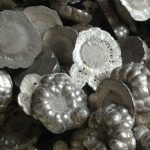Notice: Undefined index: sith_hide_share in /www/sites/alloy.wiki/index/wp-content/themes/likegoogle/single.php on line 32
Deprecated: get_settings is deprecated since version 2.1.0! Use get_option() instead. in /www/sites/alloy.wiki/index/wp-includes/functions.php on line 4862
Casting titanium flange, blank shape and size accurate, small amount of processing, low cost, but casting defects (pores, cracks, inclusion); The internal structure of casting is less streamlined (especially if it is a cutting part). Forging flange is generally lower in carbon content and less prone to rust than casting flange. Improper forging process will also appear large or uneven grain, hardening crack phenomenon, forging cost is higher than the casting flange.

Forgings can withstand higher shear and tensile forces than castings. The advantage of castings is that they can produce more complex shapes and cost less. And the internal structure is uniform, there is no casting pores, inclusions and other harmful defects; From the production process to distinguish the casting flange and forging flange, such as centrifugal flange is a casting flange.
Centrifugal flange belongs to the precision casting method, this kind of casting is much finer than the ordinary sand casting, the quality is improved a lot, not easy to appear loose structure, porosity, trachoma and other problems.
The production process of forging France
High quality billet is selected for blanking, heating, forming and cooling after forging. There are free forging, die forging and die forging. Production, according to the quality of the forging size, the number of production batch to choose different forging methods.
Basic process of free forging: in free forging, the forging shape is forged into the blank gradually through some basic deformation processes. The basic processes of free forging include upsetting, drawing, punching, bending and cutting.
Upsetting is the process of forging the original billet along the axis to reduce its height and increase its cross section. This process is often used to forge gear blanks and other disc-shaped forgings. Upsetting is divided into two kinds: total upsetting and partial upsetting.
Drawing is to increase the length of the blank, the section of the forging process, usually used to produce shaft parts blank, such as lathe spindle, connecting rod, etc.
The process of forging through or through a blank with a punch.
To bend a blank into an Angle or shape.
The process of turning one part of a blank at an Angle relative to another.
The forging process of cutting and dividing billet or cutting off the head.
Die forging is called model forging. The heated blank is placed in the forging die which is fixed on the die forging equipment. Basic processes: blanking, heating, preforging, final forging, blanking, trimming, tempering, shot peening. Common techniques include upsetting, drawing, bending, punching and forming. Common die forging equipment common die forging equipment are die hammer, hot die forging press, flat forging machine and friction press. Generally speaking, forging flange quality is better, is generally produced by die forging, crystal structure fine, high strength, of course, the price is also more expensive.
Cutting system of the flange
In the middle plate directly cut out the flange with the amount of processing inside and outside diameter and thickness of the disk, then bolt holes and waterline processing. The flange produced in this way is called cut flange, the maximum diameter of this kind of flange is limited to the width of the plate.
Rolling flange
The process of cutting the strip with the middle plate and then rolling it into a circle is called rolling and is used for the production of some large flanges. After the successful rolling process, welding, and then flat, and then the waterline and bolt hole processing technology.
Guest contributors are welcome at the Alloy Wiki.It is a weekly wiki and guide on alloy information and processing technology, while also about the vast array of opportunities that are present in manufacturing. Our team of writers consists of a Machining Material Supplier / Machinist / Tool and Die Maker, a Biomedical Engineer / Product Development Engineer, a Job Development Coordinator / Adjunct Professor, and a President and CEO of a manufacturing facility.
Link to this article:Titanium flange production process: casting, forging, heat treatment
Reprint Statement: If there are no special instructions, all articles on this site are original. Please indicate the source for reprinting:Alloy Wiki,thanks!^^


